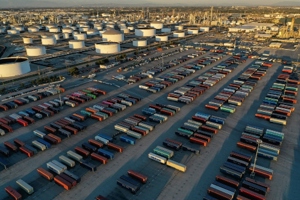Global distillate stocks low despite industrial slowdown
(Reuters) - Global distillate fuel oil cracks have strengthened slightly over the last month as inventories have not risen as much as expected given the scale of the manufacturing and freight downturn across the major economies.
Distillate fuel oils such as diesel and gas oil are mostly used for freight transport, manufacturing, and construction, with smaller quantities for residential and commercial heating.
Fuel consumption and inventories are correlated with the business cycle, especially in the merchandise rather than services sector of the economy.
Distillate consumption across North America and Europe has been slowing since the middle of 2022 in response to the downturn in manufacturing and freight activity.
At the same time, Russia has continued to export distillate fuel oil despite sanctions imposed by the United States and the European Union averting a severe supply disruption.
The resulting rise in inventories has taken some heat out of the market and halved refining margins for diesel and gas oil compared with the record peak in October 2022.
Chartbook: Global distillate stocks and prices
The gross refining margin for making U.S. diesel from Brent (both delivered in December 2023) fell to $172 per ton in late April from $316 in October 2022.
The gross margin for making European gas oil from Brent (both delivered in December 2023) fell to $114 per ton from $254 over the same period.
But over the last 4-6 weeks, diesel and gas oil cracks have stabilized and recovered slightly, as inventories have remained lower than expected a few months ago:
- In Europe, distillate inventories had increased by +32 million barrels at the end of May 2023 compared with their low point at the end of June 2022, but were still -32 million barrels (-8% or -1.00 standard deviations) below the prior 10-year seasonal average.
- In Singapore, inventories had increased by +2 million barrels by early June 2023 compared with June 2022 but were still -2.5 million barrels (-23% or -1.16 standard deviations) below the 10-year average.
- In the United States, stocks had risen by +5 million barrels since June 2022 but were still -22 million barrels (-16% or -1.18 standard deviations) below the 10-year seasonal average.
The relatively modest accumulation of inventories has forced traders to reassess the outlook, but with important regional differences based on local economic performance.
Hedge funds and other money managers have become somewhat less bearish on distillate prices since the start of May, paring their previously near-record negative position.
Portfolio investors lifted their combined futures and options position in distillates to 3 million barrels net long (20th percentile for all weeks since 2013) on June 6, up from 27 million net short (6th percentile) on May 2.
But investors are far more bullish towards U.S. diesel, with a position of 15 million barrels net long (54th percentile), reflecting tighter stocks and residual strength of the U.S. economy in the face of rising interest rates.
By contrast, they are pessimistic about European gas oil, with a net short of 12 million barrels (3rd percentile), given the regional economy is already in recession.







Comments